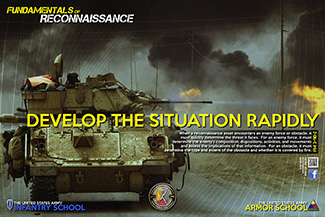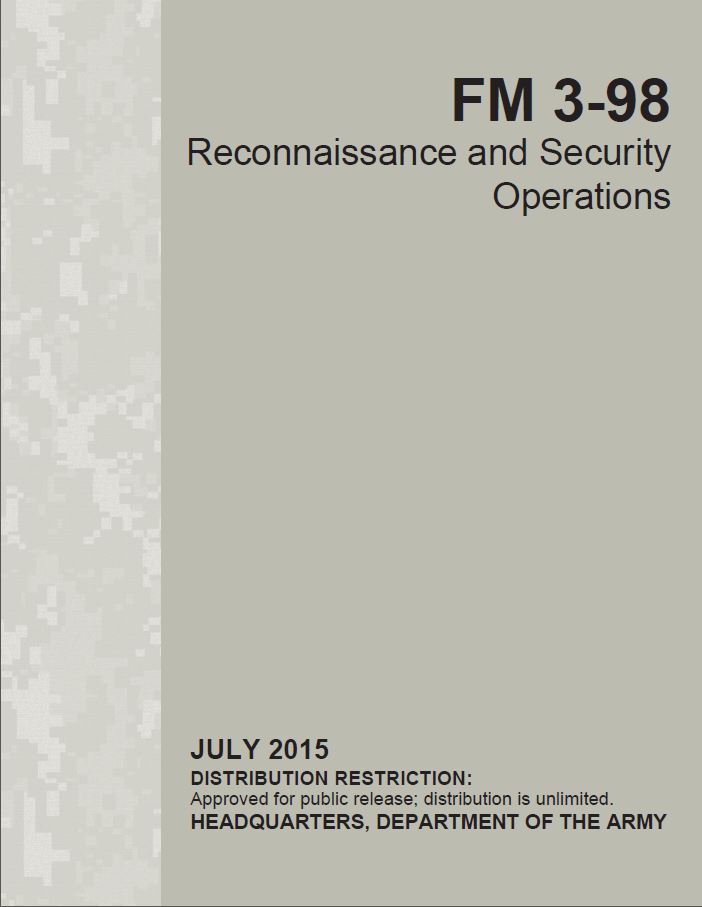DEVELOP THE SITUATION RAPIDLY
When a reconnaissance asset encounters an enemy force or an obstacle, it must quickly determine the threat it faces. For an enemy force, it must determine the enemy's composition, dispositions, activities, and movements and assess the implications of that information. For an obstacle, it must determine the type and extent of the obstacle and whether it is covered by fire. Obstacles can provide the attacker with information concerning the location of enemy forces, weapon capabilities, and organization of fires. In most cases, the reconnaissance unit developing the situation uses actions on contact.
Hamlet Clearance Operation 1967
Era: Vietnam
In 1967 elements of the 1st Cavalry Division worked to eliminate Viet Cong and North Vietnamese forces within the division’s area of operations. This basic mission required locating hostile forces and then eliminating them.
On 30 May an infantry company with an attached section of tanks conducted a reconnaissance in the vicinity of the hamlet of An Qui. Reports of a North Vietnamese unit in the area triggered the mission. As the company neared the hamlet, it received sniper fire. The company commander dispatched a platoon of infantry and the tank section to enter the hamlet and determine the size and location of the enemy force. This force moved into the small village, where it found itself engaged by a dug-in North Vietnamese battalion. The platoon became engaged in a firefight, and its focus shifted to extricating itself from the unfair combat. It managed to withdraw after losing 11 casualties.
Although the company commander opted not to shell the hamlet before sending in his platoon due to the presence of civilians, he subsequently employed available artillery and air strikes to support an attack by his entire force. The attack resulted in an additional six American dead against 99 North Vietnamese soldiers killed and three captured.
Reconnaissance Fundamentals
- Orient on the reconnaissance objective
- The platoon employed to determine the enemy presence in the hamlet remained focused on the hamlet, but its ability to gather information diminished once it found itself in a firefight.
- Retain freedom of maneuver
- In this case the platoon could not retain freedom of maneuver. It stumbled into a prepared defensive position that immediately engaged the platoon and inflicted significant loss. Part of the problem lay in the lack of stealth. The noise of the approaching tanks coupled with that of some 30 soldiers advancing provided significant warning to the North Vietnamese, already alerted to the American presence by the sniper action. In this instance, the use of a small number of dismounted scouts using stealth to determine the disposition of the enemy force might have yielded better results with fewer casualties, particularly since time does not appear to have been a factor. If the desired information had been obtained without detection, the company commander would have been able to develop alternative plans to deal with the North Vietnamese other than the massive application of firepower that no doubt destroyed the hamlet and caused a number of civilian casualties.
- Gain and maintain enemy contact
- The platoon gained contact by advancing into the village until it found itself engaged. It then maintained contact through direct fire until it could extricate itself from the lopsided firefight. Once the platoon withdrew, it effectively broke contact. Again, the use of dismounted scouts might have been able to gain and maintain contact through observation rather than direct fire engagement.
- Develop the situation rapidly
- Following the initial sniper attacks, the company commander attempted to develop the situation through the employment of a platoon with tank support. However, the enemy force controlled the sequence and timing of events once the platoon entered the hamlet. The latter’s ability to acquire details of the enemy disposition ended when it’s focus shifted to survival and extraction.
Source: Extracts of the USARV Meeting Engagement Seminar held on 14 September 1967 in Long Binh, Republic of Vietnam, p. 19, US Army Armor Branch Archives.


